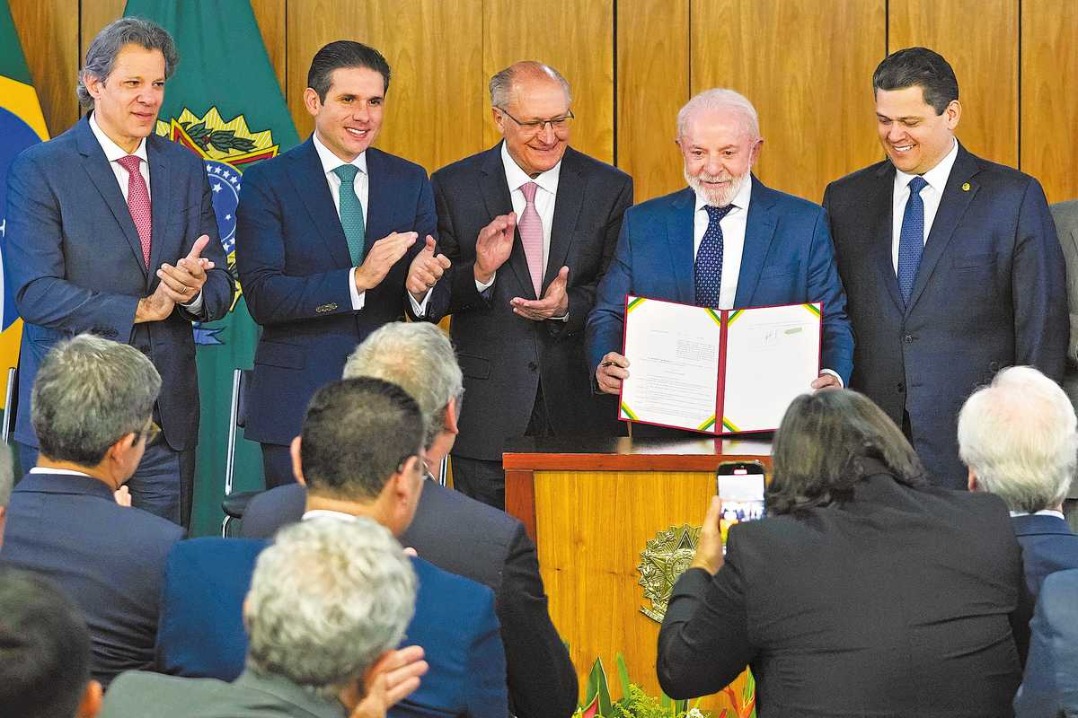Beijing, Buenos Aires expand opportunities for growth


Bilateral relations between Argentina and China reached a major milestone this year when, on Feb 19, the two countries celebrated 50 years of diplomatic relations.
Over the five decades, the partnership between the two countries has blossomed, with China currently being one of Argentina's main economic partners. More important, there is potential for further cooperation in trade, investment and other areas.
In the run-up to this landmark anniversary, Argentine President Alberto Fernandez made his first official visit to Beijing in February. This visit, as demonstrated in the joint declaration that was issued, reflected the close ties that have been forged over the past 50 years. The two countries agreed to enhance economic complementarity by increasing bilateral investments and to continue expanding bilateral trade, as well as incentivizing trade diversification.
A few weeks before the visit, the two countries held the fifth meeting of their Strategic Dialogue for Economic Cooperation and Coordination. In this dialogue, the main infrastructure projects to be developed in Argentina were identified and prioritized according to their significance in terms of enhancing national growth, providing high-quality infrastructure connectivity and ensuring environmental sustainability. Areas such as clean energy, sustainable development, logistics, infrastructure and habitat were the focus.
On Feb 4, during the presidential visit, another milestone was reached with the signing of a memorandum of understanding regarding the Belt and Road Initiative, which demonstrates both sides' willingness to strengthen bilateral relations and the close ties of friendship between our peoples.
With Argentina joining the Belt and Road Initiative, both countries need to further analyze not only the potential economic complementarities between them, but also the challenges that lie ahead and what we can or must do to successfully address these together.
More than 143 countries have joined the BRI since it was proposed by President Xi Jinping in 2013. During the Belt and Road Initiative Forum for International Cooperation, held in Beijing in May 2017, Xi referred to the Latin American and Caribbean region as the "natural extension" of the Belt and Road. Argentina has become the 20th and latest country from the region to join the initiative.
Investments in infrastructure, greater connectivity and greater inclusive development are all urgently needed for achieving economic development of the region. However, it is imperative that this development is balanced, sustainable and long-term.
The signing of the memorandum of understanding places both countries at a crucial juncture in which a significant breakthrough for Argentina-and the region-can take place. This is a unique window of opportunity which we both must take advantage of.
Both sides have the tools and the political will needed to ensure success provided that the main objectives and drivers are kept in mind.
As stated in the memorandum, cooperation under the framework of the BRI is substantive to "support the Argentine Republic in its objective of improving its export capacity and diversity". In order to achieve this, a few key issues should be considered.
First, the creation of an ad hoc working group to discuss the Belt and Road Cooperation Plan for advancing the infrastructure projects already identified by the Argentine side in the economic dialogue earlier this year is indispensable. These projects for enhancing cooperation in infrastructure in mutually beneficial areas such as roads, railroads, bridges, civil aviation, ports, energy and telecommunications will be crucial, particularly if they entail larger participation of local components in infrastructure projects to be developed with Chinese companies. There are several projects incorporated into the Integrated Plan for China-Argentina Cooperation, and others will be included in the framework of the BRI.
Second, addressing two of the long-standing challenges in Argentina's bilateral economic exchanges with China is urgent-namely the growing trade deficit and the lack of export diversification.
While the bilateral trade figures so far in 2022 are auspicious-in the January-March period, there was important growth in shipments in both directions-the trend of the Argentine trade deficit was also accentuated. In that period, it already registered 43 percent of the accumulated deficit for the year 2021.
Given that imports from China are mostly industrial goods, while Argentina's main exports to China are concentrated in a few agricultural and agri-industrial products, rapid progress is urgently needed in phytosanitary negotiations-those regarding measures for the control of plant diseases, especially in agricultural crops-as well as market access issues. In this regard, it is auspicious that the recent approval by China's Ministry of Agriculture and Rural Affairs of the HB4 strain of soy developed in Argentina will allow China to import and commercialize this soybean and its derivatives. To move forward, regular high-level meetings can help advance some other long-standing issues.
Third, foreign direct investment should be guided to productive areas that help strengthen Argentina's exports, such as the energy, mining, forestry, agri-industrial, electric mobility, animal protein and cellulose sectors.
Another important aspect is that of cooperation in the field of maritime transportation, particularly given the situation of increasing costs of sea freight, as well as the shortage of containers and transport services. Exploring the feasibility within the BRI of expanding cooperation in this area by increasing maritime transportation routes between China and Argentina to boost trade is essential.
In the future, high-level meetings between the two countries can clarify the ways to put into motion what the presidents of both countries have agreed on so that the two countries can work together to further tap, in a more dynamic way, the potential of their bilateral relationship.
The author is undersecretary for multilateral and bilateral economic relations at Argentina's Ministry of Foreign Affairs, International Trade and Worship, and director of the Latin America Committee and member of the China Working Group at the Argentine Council of International Relations. The views do not necessarily reflect those of China Daily.

































